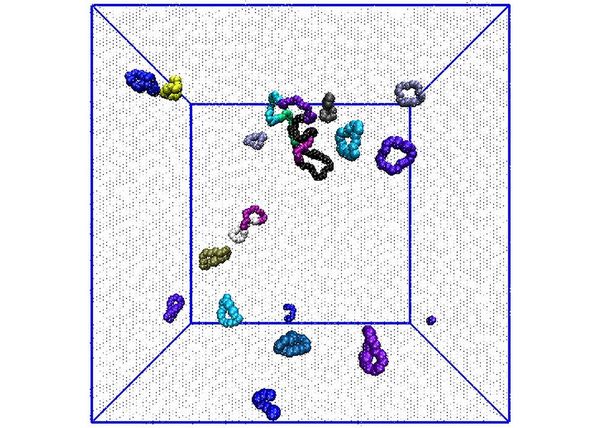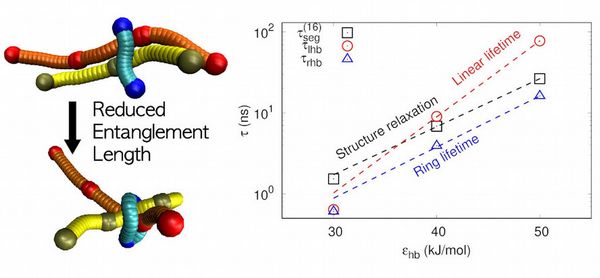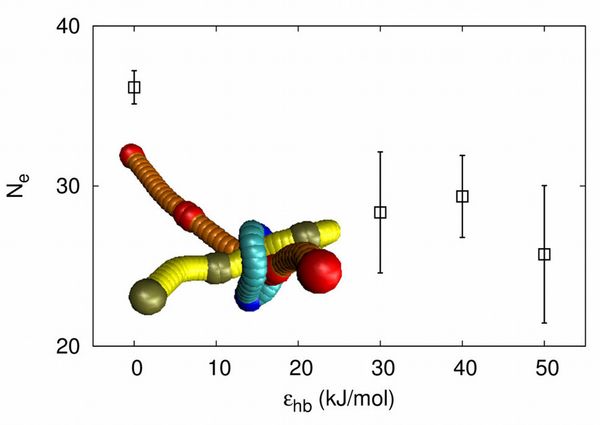MATERIALS SCIENCE AND CHEMISTRY
Dynamics of Ring-Forming Supramolecular Polymers with Hydrogen Bonding Ends
Principal Investigator:
Eunsang Lee
Affiliation:
Institute for Physics, Martin-Luther University Halle-Wittenberg
Local Project ID:
chhw05
HPC Platform used:
JUWELS of JSC
Date published:
A supramolecular polymer (SMP) refers to a polymer, a part of which is functionalized by a chemical group allowing to form physical bonds with each other. Because the physical association is, in general, reversible and is sensitive to external stimuli, e.g., temperature, mechanical force, pH, the rheological property of the SMP is can be reversibly controlled. Therefore, SMPs have gained a lot of attention in various fields of studies because their potential application as smart materials.
From the physical point of view, one of the most important factors determining rehological properties of SMPs is the topology of aggregates, as polymers of different topology, e.g., linear, ring or branched polymers, without functional groups have very difference mechanisms of diffusion and stress relaxation. Ring polymers, as an example, have a topology whose ends are intrinsically connected to each other, which leads to a different structure relaxation mechanism from linear polymers.
Many experimental and simulation studies have shown that a threading configuration between rings reduces diffusivity of the rings and affects the rheology of the melt. When a very small amount of rings is added to a linear polymer melt, the diffusion of the linear polymer is also slowed down because it is additionally entangled by ring polymers. For SMPs with functional groups which can make only a pairwise association, linear- and ring-shaped aggregates are formed. The numbers and sizes of the aggregates thermally fluctuate, which will eventually determine the rheology of the SMP. However, although several functional groups used for SMPs are known to be pairwise, the topological effect of aggregates on the SMP rheology is poorly understood. Therefore, we performed molecular dynamics simulations of SMPs with pairwise-associating stickers at melt-like density and investigated the relation between the topology of aggregates and the dynamic properties.[1]
In this work, we used a coarse-grained polyethylene glycol model which was developed by ourselves.[2,3] A bead-spring description with Lennard-Jones nonbonded and harmonic bond length potentials for a polymer is used, and the Gaussian attraction potential is employed to describe a hydrogen bond between two stickers. The directionality of the hydrogen bond can be controlled by the width of the Gaussian, so as to restrict our sticker to associate only by a pairwise manner.
We simulated six different linear polymer lengths from 16 to 512 in terms of the number of beads in a polymer including the sticker beads replaced at both ends. The total number of beads in a simulation box is 131,072. Due to the long lifetime of the association and the slow relaxation of the resulting aggregates, we need long simulation time for longer than 2 μs. For each polymer length, we performed simulations for three different association strengths. Simulations were carried out at the JUWELS supercomputer with the ESPResSo++ package in which the Gaussian attraction potential is implemented. Roughly 3 million core hours of computing time were consumed for the project.
Figure 1 highlights ring-shaped aggregates from our simulation snapshot for the number of beads in a polymer of 16. This figure shows that linear aggregates are much more probable than ring aggregates. Moreover, a short ring is more probable than a long ring because the probability of two ends of a linear aggregate meeting each other in space gets smaller as the length of the linear aggregates increases. We found that even the small fraction of rings critically affect the dynamics of the whole SMP. We also found that the fraction of ring aggregates increases with increasing the association strength.
The threading configuration shown in Figure 2 clearly shows the stress relaxation mechanism of the SMP. When a ring-shaped aggregate is formed by association between stickers, a few linear aggregates are enclosed in the ring. Because the majority of rings are small-sized, the motion of the linear polymer perpendicular to its contour is highly suppressed. The only way to relax its stress is either to diffuse along its contour or to break the association of the ring aggregate. We found that the segmental structure relaxation time of a single polymer is proportional to the average lifetime of associations in ring aggregates (the right graph of Figure 2), which implies that ring breaking is the dynamically controlling mechanism.
The effect of the threading configuration can also be described as a reduced effective entanglement length of the linear aggregates as shown in Figure 3. In addition to the suppressed motion perpendicular to the contour, a ring acts as a slip-link and highly constraints the motion of the threading linear aggregates when more than one linear aggregate is threading the ring. Therefore, the stress of the SMP is partially stored by the ring-linear threading configuration and can be only relaxed when the ring breaks.
This work provides the first direct evidence of the ring topology affecting the dynamics of SMPs, which would further broaden the possibility of tailoring novel SMP properties taking into account ring-topological effects.
References
[1] E. Lee and W. Paul, Additional entanglement effect imposed by small-sized ring aggregates in supramolecular polymer melts: Molecular dynamics simulation study, Macromolecules, 53, 1674-1584, 2020
[2] E. Lee and W. Paul, Thermodynamics of single polyethylene and polybutylene glycols with hydrogen-bonding ends: a transition from looped to open conformations, J. Chem. Phys. 148, 082905, 2018
[3] E. Lee and W. Paul, Morphology and thermodynamics of polymers with monofunctional hydrogen bonding ends in dilute and semidilute concentration, Phys. Rev. E, 100, 012502, 2019
Scientific Contact
Dr. Eunsang Lee
Martin Luther Universität (MLU), Institut für Physik
D-06099 Halle (Saale) – Germany
new contact data:
Dr. Eunsang Lee
Eduard-Zintl-Institut für Anorganische und Physikalische Chemie
Technische Universität Darmstadt
Alarich-Weiss-Str. 8
D-64287 Darmstadt (Germany)
e-mail: e.lee@theo.chemie.tu-darmstadt.de
JSC project ID: chwu05
January 2021


